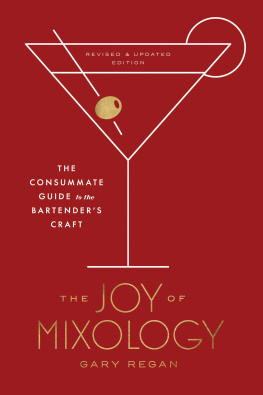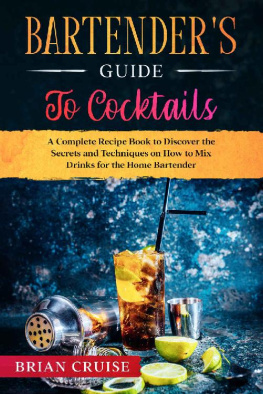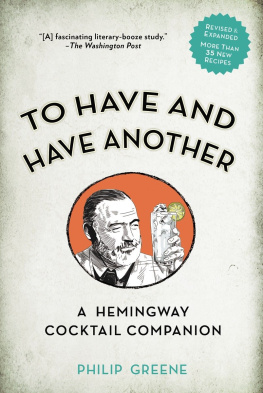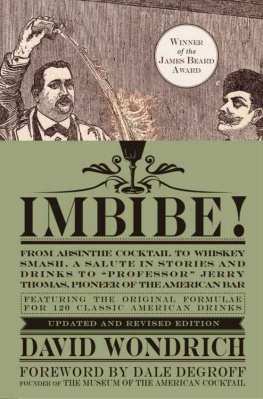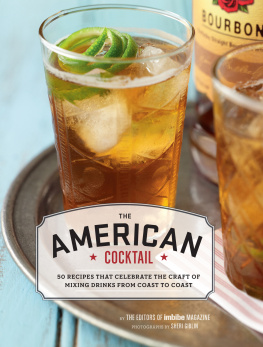Contents
ACKNOWLEDGMENTS
Give thanks to God. After all, its his language youre cashing in on.
D ANIELLE E GNEW
I HAD SO MANY PEOPLE TO THANK when I originally penned the first edition of this book in 2003, and now, some fifteen years later, Ive many more folk to add. If I start to try to list everyone, I know Ill be sorry. The book will go to the printer, and two days later Ill think of a few more people who I forgot to include. So Im not going to name anyone at all.
I will, though, thank the global bartending community for all the support youve given to me over the years. Ive learned much from twenty-first-century bartenders during the past decade or more, so Id like to thank you all for letting me hang with you, watch you, and feel like one of the gang. Without you, my Bartender Brothers and Sisters, my life could never have been as rich as its become. God Bless each and every one of you.
And theres no way that this book is going anywhere near a printer before I thank my wonderful new wife, Amy, for showing me what true love is all about. In our next lives, Babe, lets try to meet up sooner rather than later, huh?
GARY REGAN is the author of The Negroni, The Bartenders Bible, The Martini Companion, The Cocktailian Chronicles, and others. A consultant to major spirits producers such as Diageo and Pernod Ricard, he holds workshops, judges cocktail competitions, and lectures around the world. He lives in the Hudson Valley, New York. Visit him at gazregan.com and follow him on social media @gazregan.
TABLES AND CHARTS
Minim.There are 60 minims in a dram or teaspoon; 120 in a dessertspoon; 240 in a tablespoon; 480 in an ounce; 960 in a wineglass; 1,920 in a teacup or gill; 3,840 in a breakfast-cup or tumbler; 7,680 in a pint; 15,360 in a quart; 61,440 in a gallon; 2,935,360 in a barrel; 3,970,720 in a hogshead. Its equivalent weight is .9493 grams. A Minim is equal to a drop.
C UYLER R EYNOLDS , The Banquet Book, 1902
BOTTLE SIZES
375 MILLILITERS: half a standard spirit or wine bottle
750 MILLILITERS: standard spirit or wine bottle
MAGNUM: 1.5 liters
DOUBLE MAGNUM: 3 liters
JEROBOAM: 3 liters
REHOBOAM: 4.5 liters
IMPERIAL: 6 liters
METHUSELAH: 6 liters
SALMANAZAR: 8 to 9 liters
BALTHAZAR: 12.3 liters
NEBUCHADNEZZAR: 15.4 liters
FRESH FRUIT JUICE YIELDS
The following yields are a result of some five years of noting how much juice I squeezed from each fruit, then arriving at an average.
1 GRAPEFRUIT yields 6 ounces juice
1 LEMON yields 1 ounces juice
1 LIME yields 1 ounce juice
1 ORANGE yields 2 to 3 ounces juice
FLUID MEASUREMENT CONVERSIONS
There is much confusion about the term gill, and I believe this arises because of the confusion between British and American pints. Although British and American fluid ounces are slightly different (the British measurement containing four-hundredths of an ounce more than the American ounce), its generally accepted that a British pint contains 20 ounces and a pint in the States contains 16 ouncesthe difference in ounce size being disregarded.
A gill, which is a more or less arcane measurement, usually referred to one-fourth of a pint; so in Britain, a gill would be 5 ounces, and in the States, it would contain 4 ounces.
BARSPEAK | U.S. | U.K. | METRIC |
1 pony | 1 ounce | 1.04 ounces | 2.96 centiliters |
1 jigger | 1.5 ounces | 1.56 ounces | 4.44 centiliters |
1 gill | 4 ounces | 5 ounces | 14.19 centiliters |
U.S. | U.K. | METRIC |
1 ounce | 1.04 ounces | 2.96 centiliters |
1.5 ounces | 1.56 ounces | 4.44 centiliters |
1 pint | 0.83 pint | 47.32 centiliters |
1 gallon | 0.83 gallon | 3.79 liters |
U.K. | U.S. | METRIC |
1 ounce | 0.961 ounce | 2.841 centiliters |
1 pint | 1.201 pints | 56.825 centiliters |
1 gallon | 1.201 gallons | 4.546 liters |
METRIC | U.S. | U.K. |
1 liter | 33.82 ounces | 35.195 ounces |
750 milliliters | 25.36 ounces | 26.396 ounces |
1 milliliter | 0.034 ounce | 0.035 ounce |
1 centiliter | 0.338 ounce | 0.352 ounce |
HOW MANY SHOTS ARE IN THAT BOTTLE?
BOTTLE SIZE | SHOT SIZE | NUMBER OF SHOTS |
750 milliliters | 1 ounce | 25.36 |
750 milliliters | 1 ounces | 20.29 |
750 milliliters | 1 ounces | 16.91 |
750 milliliters | 2 ounces | 12.68 |
750 milliliters | 2 ounces | 10.14 |
1 liter | 1 ounce | 33.82 |
1 liter | 1 ounces | 27.01 |
1 liter | 1 ounces | 22.55 |
1 liter | 2 ounces | 16.91 |
1 liter | 2 ounces | 13.53 |
HOW MUCH ALCOHOL IS IN THAT BOTTLE?
Thankfully, most producers of alcoholic beverages have started to steer away from using proof as an indicator of the amount of alcohol in any one product and now use abv , alcohol by volume, to show strength. Therefore, a bottle of liquor at 40 percent abv contains 40 percent pure alcohol by volume (as opposed to by weight, which would get very confusing).
Britain, which used to use the Sikes scale to display proof, now uses the European scale set down by the International Organization of Legal Metrology (IOLM). This scale, for all intents and purposes the same as the Gay-Lussac scale, which was previously used by much of mainland Europe, was adopted by all the countries in the European Community in 1980. Using the IOLM scale or the Gay-Lussac scale is essentially the same as measuring alcohol by volume, except that their figures are expressed as degrees, not percentages.
ALCOHOL BY VOLUME | U.S. PROOF | IOLM |
40% | | |
43% | | |
50% | | |
GLOSSARY
ABSINTHE A high-proof spirit with a predominant anise flavor. Absinthe was declared illegal in the United States in 1912, because the wormwood used in its production was deemed to be harmful.
ABRICOTINE An apricot-flavored liqueur from France.
ADVOCAAT A brandy-based liqueur made with eggs, vanilla, and various other flavorings.
AGED SPIRITS Spirits labeled with a specific age statement have spent the indicated number of years aging in wooden barrels. The contents of the bottle can contain spirits older than the given age, but not younger.
AGING DISTILLED SPIRITS Some spirits, such as whiskey, aged brandy, and aged rum, require time in oak barrels before being bottled. During that time, the congeners, which are basically impurities in the liquor, oxidize, forming acids that react with other congeners to produce pleasant-tasting esters. The alcohol also reacts with the wood, extracting vanillins, wood sugars, tannins, and color.

